DESCRIPTION
Lactated Ringer’s Irrigation is a sterile, nonpyrogenic solution of electrolytes in water for injection intended only for sterile irrigation, washing and rinsing purposes. The composition is based on a modification of the injectable formula originally known as Hartmann’s Solution.
Each 100 mL of Lactated Ringer’s Irrigation contains: Sodium chloride 600 mg; sodium lactate, anhydrous 310 mg; potassium chloride 30 mg; calcium chloride, dihydrate 20 mg. The pH is 6.75 (6.0 — 7.5). The solution is isotonic (273 mOsmol/liter, calc.) and has the following electrolyte content (mEq/liter): Sodium (Na+) 130; potassium (K+) 4; calcium (Ca++) 3; chloride (Cl¯) 109 and lactate (CH3CH(OH)COO¯) 28. Contains sodium hydroxide and may contain hydrochloric acid for pH adjustment.
The solution contains no bacteriostatic or antimicrobial agent or added buffer and is intended only for use as a single-dose or short procedure irrigation. When smaller volumes are required, the unused portion should be discarded. Lactated Ringer’s Irrigation may be classified as a sterile irrigant, wash, rinse and pharmaceutical vehicle.
Calcium Chloride, USP is chemically designated calcium chloride, dihydrate (CaCl2 • 2H2O), white fragments or granules freely soluble in water.
Potassium Chloride, USP is chemically designated KCl, a white granular powder freely soluble in water.
Sodium Chloride, USP is chemically designated NaCl, a white crystalline powder freely soluble in water.
Sodium Lactate, USP is chemically designated C3H5NaO3, a 60% aqueous solution miscible in water.
It has the following structural formula:
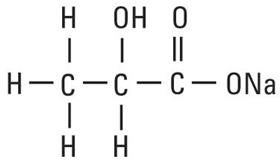
Water for Injection, USP is chemically designated H2O.
The plastic container is made from a multilayered film specifically developed for parenteral drugs. It contains no plasticizers. The solution contact layer is a rubberized copolymer of ethylene and propylene. The container-solution unit is a closed system and is not dependent upon entry of external air during administration. The container is overwrapped to provide protection from the physical environment and to provide an additional moisture barrier when necessary.
Not made with natural rubber latex, PVC or DEHP.
CLINICAL PHARMACOLOGY
Lactated Ringer’s Irrigation exerts a mechanical cleansing action for sterile irrigation of body cavities, tissues or wounds, indwelling urethral catheters and surgical drainage tubes, and for washing, rinsing or soaking surgical dressings, instruments and laboratory specimens. It also serves as a vehicle for drugs used for irrigation or other pharmaceutical preparations.
Lactated Ringer’s Irrigation provides an isotonic irrigation with the same ionic constituents as Lactated Ringer’s Injection, USP, a modification of Hartmann’s Solution.
Lactated Ringer’s Irrigation is considered generally compatible with living tissues and organs.
Calcium chloride in water dissociates to provide calcium (Ca++) and chloride (Cl¯) ions. They are normal constituents of the body fluids and are dependent on various physiologic mechanisms for maintenance of balance between intake and output. Approximately 80% of body calcium is excreted in the feces as insoluble salts; urinary excretion accounts for the remaining 20%.
Potassium chloride in water dissociates to provide potassium (K+) and chloride (Cl¯) ions. Potassium is the chief cation of body cells (160 mEq/liter of intracellular water). It is found in low concentration in plasma and extracellular fluids (3.5 to 5.0 mEq/liter in a healthy adult). Potassium plays an important role in electrolyte balance.
Normally about 80 to 90% of the potassium intake is excreted in the urine; the remainder in the stools and to a small extent, in the perspiration. The kidney does not conserve potassium well so that during fasting or in patients on a potassium-free diet, potassium loss from the body continues resulting in potassium depletion.
Sodium chloride in water dissociates to provide sodium (Na+) and chloride (Cl¯) ions. Sodium (Na+) is the principal cation of the extracellular fluid and plays a large part in the therapy of fluid and electrolyte disturbances. Chloride (Cl¯) has an integral role in buffering action when oxygen and carbon dioxide exchange occurs in the red blood cells. The distribution and excretion of sodium (Na+) and chloride (Cl¯) are largely under the control of the kidney which maintains a balance between intake and output.
Sodium lactate in water dissociates to provide sodium (Na+) and lactate (C3H5O3¯) ions. The lactate anion provides an alkalizing effect resulting from simultaneous removal by the liver of lactate and hydrogen ions. In the liver, the lactate is metabolized to glycogen which is ultimately converted to carbon dioxide and water by oxidative metabolism.
The lactate anion acts as a source (alternate) of bicarbonate when normal production and utilization of lactic acid is not impaired as a result of disordered lactate metabolism. Since metabolic conversion is dependent on the integrity of cellular oxidative processes, lactate may be inadequate or ineffective as a source of bicarbonate in patients suffering from acidosis associated with shock or other disorders involving reduced perfusion of body tissues. When oxidative activity is intact, one to two hours time is required for metabolism of lactate.
Water is an essential constituent of all body tissues and accounts for approximately 70% of total body weight. Average normal adult daily requirement ranges from two to three liters (1 to 1.5 liters each for insensible water loss by perspiration and urine production).
Water balance is maintained by various regulatory mechanisms. Water distribution depends primarily on the concentration of electrolytes in the body compartments and sodium (Na+) plays a major role in maintaining physiologic equilibrium.
INDICATIONS AND USAGE
Lactated Ringer’s Irrigation is indicated for all general irrigation, washing and rinsing purposes which permit use of a sterile, nonpyrogenic electrolyte solution.
CONTRAINDICATIONS
NOT FOR INJECTION BY USUAL PARENTERAL ROUTES.
An electrolyte solution should not be used for irrigation during electrosurgical procedures.
WARNINGS
FOR IRRIGATION ONLY. NOT FOR INJECTION.
Irrigating fluids have been demonstrated to enter the systemic circulation in relatively large volumes; thus this irrigation must be regarded as a systemic drug. Absorption of large amounts can cause fluid and/or solute overloading resulting in dilution of serum electrolyte concentrations, overhydration, congested states or pulmonary edema.
The risk of dilutional states is inversely proportional to the electrolyte concentrations of administered parenteral solutions. The risk of solute overload causing congested states with peripheral and pulmonary edema is directly proportional to the electrolyte concentrations of such solutions.
Do not warm container over 150°F (66°C).
PRECAUTIONS
Do not use for irrigation that may result in absorption into the blood.
Caution should be observed when the solution is used for continuous irrigation or allowed to “dwell” inside body cavities because of possible absorption into the blood stream and the production of circulatory overload.
Aseptic technique is essential with the use of sterile solutions for irrigation of body cavities, wounds and urethral catheters or for wetting dressings that come in contact with body tissues.
The flexible container is designed for use with nonvented irrigation sets. When used for irrigation via irrigation equipment, the administration set should be attached promptly. Unused portions should be discarded and a fresh container of appropriate size used for the start-up of each cycle or repeat procedure. For repeated irrigations of urethral catheters, a separate container should be used for each patient.
Do not administer unless solution is clear and container is undamaged. Discard unused portion.
ADVERSE REACTIONS
Possible adverse effects arising from the irrigation of body cavities, tissues, or indwelling catheters and tubes are usually avoidable when proper procedures are followed. Displaced catheters or drainage tubes can lead to irrigation or infiltration of unintended structures or cavities. Excessive volume or pressure during irrigation of closed cavities may cause undue distension or disruption of tissues. Accidental contamination from careless technique may transmit infection.
Should any adverse reaction occur, discontinue the irrigant, evaluate the patient, institute appropriate therapeutic countermeasures and save the remainder of the fluid for examination if deemed necessary.
OVERDOSAGE
In the event of overhydration or solute overload, re-evaluate the patient and institute appropriate corrective measures. (See WARNINGS, PRECAUTIONS and ADVERSE REACTIONS.)
DOSAGE AND ADMINISTRATION
The dose is dependent upon the capacity or surface area of the structure to be irrigated and the nature of the procedure. When used as a vehicle for other drugs, the manufacturer’s recommendations should be followed.
Drug Interactions
Additives may be incompatible. Consult with pharmacist, if available. When introducing additives, use aseptic technique, mix thoroughly and do not store.
Parenteral drug products should be inspected visually for particulate matter and discoloration prior to administration, whenever solution container permits. (See PRECAUTIONS.)
HOW SUPPLIED
Lactated Ringer's Irrigation is supplied sterile and nonpyrogenic in single-dose 3000 mL flexible irrigation container packaged 4 per case.
| NDC | REF | Size |
| 0264-7389-60 | R8306 | 3000 mL |
Exposure of pharmaceutical products to heat should be minimized. Avoid excessive heat. Protect from freezing. Store at 20°–25°C (68°–77°F) [see USP Controlled Room Temperature]; however, brief exposure up to 40°C does not adversely affect the product.
Do not warm container over 150°F (66°C).
Instructions for Preparation and Administration
Not for injection.
Not for use with pressurized irrigation systems.
Aseptic technique is required.
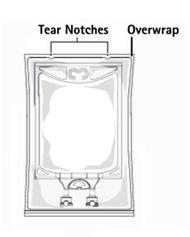
- Inspect irrigation bag: overwrap and primary bag.
- Do not use if overwrap has been damaged.
- Do not use unless solution is clear and closure is intact.
1. To open: Tear overwrap starting from the tear notches. (Figure 1)
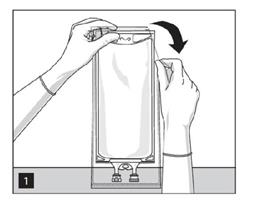
2. Prepare medication port by removal of aluminum foil. (Figure 2a)
- Puncture resealable medication port by using 19 – 22 gauge needle and inject additive(s). (Figure 2b)
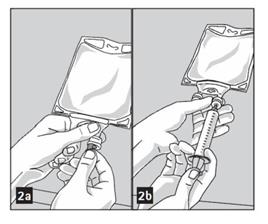
- Medication port must be swabbed with disinfection agent before re-puncturing.
- Mix solution and medication thoroughly. (Figure 3a)
- Check admixture visually for particulate matter. (Figure 3b)

For Irrigation purposes while using an infusion set:
3. Remove aluminum foil from outlet/set port at the bottom of container (Figure 4a) and attach administration set (Figure 4b): use non-vented infusion set or close air vent on a vented set. Refer to directions for use accompanying the administration set.

4. Hang bag on IV Pole. (Figure 5)
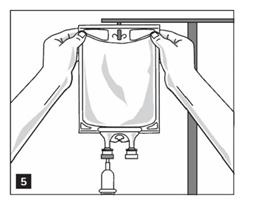
LD-442-3 Y36-002-962
Package Insert
Rx only
Revised: August 2018
B. Braun Medical Inc.
Bethlehem, PA 18018-3524 USA
1-800-227-2862
PRINCIPAL DISPLAY PANEL - 3 Liter Container
LACTATED RINGER’S IRRIGATION
ISOTONIC SOLUTION FOR IRRIGATION
CONTRAINDICATIONS: NOT FOR INJECTION
REF R8306
NDC 0264-7389-60
LOT
EXP.
3000 mL
Each 100 mL contains Sodium Chloride 600 mg; Sodium
Lactate, Anhyd 310 mg; Potassium Chloride 30 mg; Calcium
Chloride, Dihydrate 20 mg in Water for Injection. Contains
NaOH and may contain HCI for pH adjustment.
Electrolytes per 1000 mL (Not including pH adjustment):
Sodium 130 mEq; Potassium 4 mEq; Calcium 3 mEq;
Chloride 109 mEq; Lactate 28 mEq.
273 mOsmol/liter (Calc.) pH 6.75 (6.0 to 7.5)
Sterile, nonpyrogenic.
Use only if solution is clear and container and seal are intact.
Warnings: Do not warm container over 150°F (66°C).
Single unit container. Contains no bacteriostatic agent.
Discard unused portion. Use aseptic technique.
Store at 20°-25°C (68°-77°F) [see USP Controlled Room
Temperature]. Avoid excessive heat. Protect from freezing.
Do not remove overwrap until ready for use.
See Package Insert.
Not made with natural rubber latex, PVC or DEHP.
Rx only
Y38-000-062 LD-252-4
B. Braun Medical Inc.
Bethlehem, PA 18018-3524 USA
1-800-227-2862
SET
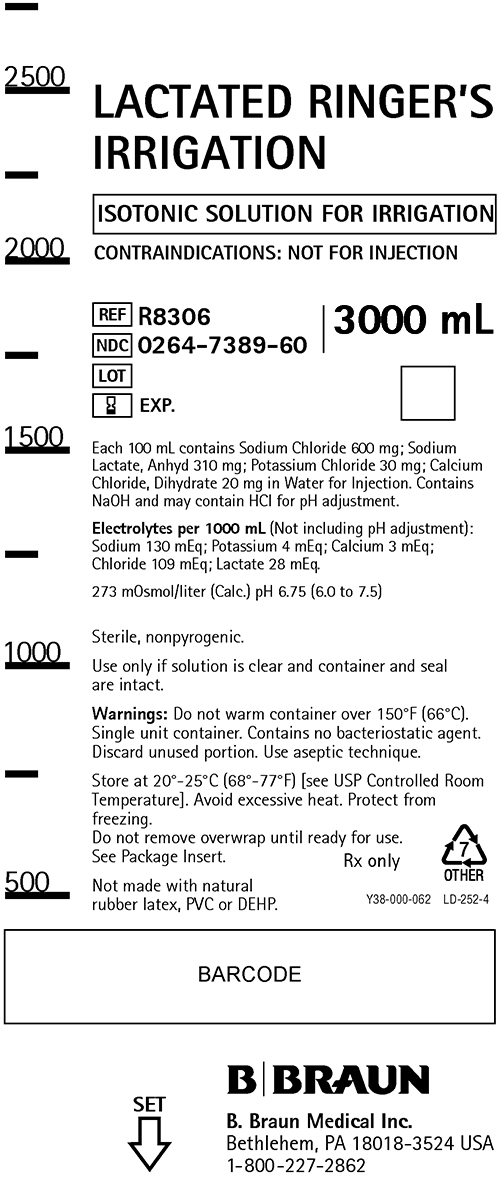
Lactated Ringer's Irrigation 3L Container Label